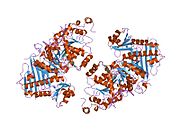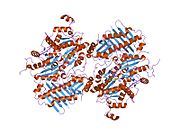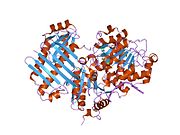CASC3
| CASC3 | |||||||||||||||||||||||||||||||||||||||||||||||||||
|---|---|---|---|---|---|---|---|---|---|---|---|---|---|---|---|---|---|---|---|---|---|---|---|---|---|---|---|---|---|---|---|---|---|---|---|---|---|---|---|---|---|---|---|---|---|---|---|---|---|---|---|
 | |||||||||||||||||||||||||||||||||||||||||||||||||||
| |||||||||||||||||||||||||||||||||||||||||||||||||||
| Identifiers | |||||||||||||||||||||||||||||||||||||||||||||||||||
| Aliases | CASC3, BTZ, MLN51, cancer susceptibility candidate 3, cancer susceptibility 3, exon junction complex subunit, CASC3 exon junction complex subunit | ||||||||||||||||||||||||||||||||||||||||||||||||||
| External IDs | OMIM: 606504; MGI: 2179723; HomoloGene: 7208; GeneCards: CASC3; OMA:CASC3 - orthologs | ||||||||||||||||||||||||||||||||||||||||||||||||||
| |||||||||||||||||||||||||||||||||||||||||||||||||||
| |||||||||||||||||||||||||||||||||||||||||||||||||||
| |||||||||||||||||||||||||||||||||||||||||||||||||||
| |||||||||||||||||||||||||||||||||||||||||||||||||||
| |||||||||||||||||||||||||||||||||||||||||||||||||||
| Wikidata | |||||||||||||||||||||||||||||||||||||||||||||||||||
| |||||||||||||||||||||||||||||||||||||||||||||||||||
Protein CASC3 is a protein that in humans is encoded by the CASC3 gene.[5][6][7]
Function
The product of this gene is a core component of the exon junction complex (EJC), a protein complex that is deposited on spliced mRNAs at exon-exon junctions and functions in nonsense-mediated mRNA decay (NMD). The encoded protein binds RNA and interacts with two other EJC core components. It is predominantly located in the cytoplasm, but shuttles into the nucleus where it localizes to nuclear speckles.[7]
References
- ^ a b c GRCh38: Ensembl release 89: ENSG00000108349 – Ensembl, May 2017
- ^ a b c GRCm38: Ensembl release 89: ENSMUSG00000078676 – Ensembl, May 2017
- ^ "Human PubMed Reference:". National Center for Biotechnology Information, U.S. National Library of Medicine.
- ^ "Mouse PubMed Reference:". National Center for Biotechnology Information, U.S. National Library of Medicine.
- ^ Tomasetto C, Regnier C, Moog-Lutz C, Mattei MG, Chenard MP, Lidereau R, Basset P, Rio MC (Jan 1996). "Identification of four novel human genes amplified and overexpressed in breast carcinoma and localized to the q11-q21.3 region of chromosome 17". Genomics. 28 (3): 367–76. doi:10.1006/geno.1995.1163. PMID 7490069.
- ^ Arriola E, Marchio C, Tan DS, Drury SC, Lambros MB, Natrajan R, Rodriguez-Pinilla SM, Mackay A, Tamber N, Fenwick K, Jones C, Dowsett M, Ashworth A, Reis-Filho JS (Apr 2008). "Genomic analysis of the HER2/TOP2A amplicon in breast cancer and breast cancer cell lines". Lab Invest. 88 (5): 491–503. doi:10.1038/labinvest.2008.19. PMID 18332872.
- ^ a b "Entrez Gene: CASC3 cancer susceptibility candidate 3".
External links
- Human CASC3 genome location and CASC3 gene details page in the UCSC Genome Browser.
Further reading
- Varis A, Wolf M, Monni O, et al. (2002). "Targets of gene amplification and overexpression at 17q in gastric cancer". Cancer Res. 62 (9): 2625–9. PMID 11980659.
- Degot S, Régnier CH, Wendling C, et al. (2002). "Metastatic Lymph Node 51, a novel nucleo-cytoplasmic protein overexpressed in breast cancer". Oncogene. 21 (28): 4422–34. doi:10.1038/sj.onc.1205611. PMID 12080473.
- Strausberg RL, Feingold EA, Grouse LH, et al. (2003). "Generation and initial analysis of more than 15,000 full-length human and mouse cDNA sequences". Proc. Natl. Acad. Sci. U.S.A. 99 (26): 16899–903. Bibcode:2002PNAS...9916899M. doi:10.1073/pnas.242603899. PMC 139241. PMID 12477932.
- Macchi P, Kroening S, Palacios IM, et al. (2003). "Barentsz, a new component of the Staufen-containing ribonucleoprotein particles in mammalian cells, interacts with Staufen in an RNA-dependent manner". J. Neurosci. 23 (13): 5778–88. doi:10.1523/jneurosci.23-13-05778.2003. PMC 6741274. PMID 12843282.
- Ota T, Suzuki Y, Nishikawa T, et al. (2004). "Complete sequencing and characterization of 21,243 full-length human cDNAs". Nat. Genet. 36 (1): 40–5. doi:10.1038/ng1285. PMID 14702039.
- Palacios IM, Gatfield D, St Johnston D, Izaurralde E (2004). "An eIF4AIII-containing complex required for mRNA localization and nonsense-mediated mRNA decay". Nature. 427 (6976): 753–7. Bibcode:2004Natur.427..753P. doi:10.1038/nature02351. PMID 14973490. S2CID 4400243.
- Degot S, Le Hir H, Alpy F, et al. (2004). "Association of the breast cancer protein MLN51 with the exon junction complex via its speckle localizer and RNA binding module". J. Biol. Chem. 279 (32): 33702–15. doi:10.1074/jbc.M402754200. PMID 15166247.
- Gerhard DS, Wagner L, Feingold EA, et al. (2004). "The status, quality, and expansion of the NIH full-length cDNA project: the Mammalian Gene Collection (MGC)". Genome Res. 14 (10B): 2121–7. doi:10.1101/gr.2596504. PMC 528928. PMID 15489334.
- Kim YK, Furic L, Desgroseillers L, Maquat LE (2005). "Mammalian Staufen1 recruits Upf1 to specific mRNA 3'UTRs so as to elicit mRNA decay". Cell. 120 (2): 195–208. doi:10.1016/j.cell.2004.11.050. PMID 15680326. S2CID 16786108.
- Ballut L, Marchadier B, Baguet A, et al. (2005). "The exon junction core complex is locked onto RNA by inhibition of eIF4AIII ATPase activity". Nat. Struct. Mol. Biol. 12 (10): 861–9. doi:10.1038/nsmb990. PMID 16170325. S2CID 1359792.
- Tange TØ, Shibuya T, Jurica MS, Moore MJ (2006). "Biochemical analysis of the EJC reveals two new factors and a stable tetrameric protein core". RNA. 11 (12): 1869–83. doi:10.1261/rna.2155905. PMC 1370875. PMID 16314458.
- Kimura K, Wakamatsu A, Suzuki Y, et al. (2006). "Diversification of transcriptional modulation: large-scale identification and characterization of putative alternative promoters of human genes". Genome Res. 16 (1): 55–65. doi:10.1101/gr.4039406. PMC 1356129. PMID 16344560.
- Shibuya T, Tange TØ, Stroupe ME, Moore MJ (2006). "Mutational analysis of human eIF4AIII identifies regions necessary for exon junction complex formation and nonsense-mediated mRNA decay". RNA. 12 (3): 360–74. doi:10.1261/rna.2190706. PMC 1383576. PMID 16495234.
- Andersen CB, Ballut L, Johansen JS, et al. (2006). "Structure of the exon junction core complex with a trapped DEAD-box ATPase bound to RNA". Science. 313 (5795): 1968–72. Bibcode:2006Sci...313.1968A. doi:10.1126/science.1131981. PMID 16931718. S2CID 26409491.
- Olsen JV, Blagoev B, Gnad F, et al. (2006). "Global, in vivo, and site-specific phosphorylation dynamics in signaling networks". Cell. 127 (3): 635–48. doi:10.1016/j.cell.2006.09.026. PMID 17081983. S2CID 7827573.
- Baguet A, Degot S, Cougot N, et al. (2007). "The exon-junction-complex-component metastatic lymph node 51 functions in stress-granule assembly". J. Cell Sci. 120 (Pt 16): 2774–84. doi:10.1242/jcs.009225. PMID 17652158.
- v
- t
- e
-
 2hyi: Structure of the human exon junction complex with a trapped DEAD-box helicase bound to RNA
2hyi: Structure of the human exon junction complex with a trapped DEAD-box helicase bound to RNA -
 2j0q: THE CRYSTAL STRUCTURE OF THE EXON JUNCTION COMPLEX AT 3.2 A RESOLUTION
2j0q: THE CRYSTAL STRUCTURE OF THE EXON JUNCTION COMPLEX AT 3.2 A RESOLUTION -
 2j0s: THE CRYSTAL STRUCTURE OF THE EXON JUNCTION COMPLEX AT 2.2 A RESOLUTION
2j0s: THE CRYSTAL STRUCTURE OF THE EXON JUNCTION COMPLEX AT 2.2 A RESOLUTION -
 2j0u: THE CRYSTAL STRUCTURE OF EIF4AIII-BARENTSZ COMPLEX AT 3.0 A RESOLUTION
2j0u: THE CRYSTAL STRUCTURE OF EIF4AIII-BARENTSZ COMPLEX AT 3.0 A RESOLUTION
 | This article on a gene on human chromosome 17 is a stub. You can help Wikipedia by expanding it. |
- v
- t
- e





















